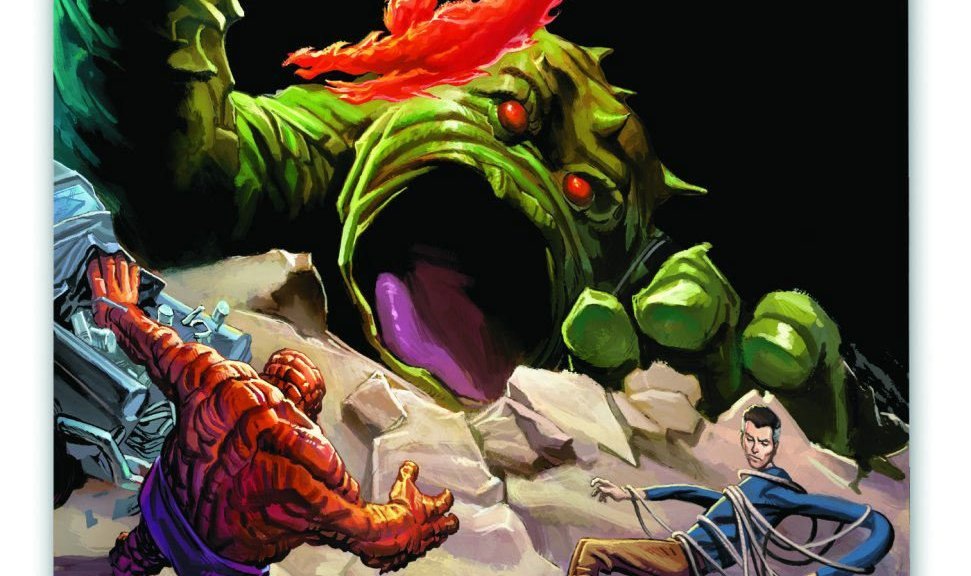Fantastic Four Vol. 1 (Marvel Masterworks)
Pros: Pretty strong character development and interesting villains
Cons: Dated storytelling style and artwork can make it a tough read
While during a science exhibition into Earth’s orbit; Reed Richards, (Mr. Fantastic) Sue Storm (Invisible Girl), Ben Grimm (The Thing), and Johnny Storm ( The Human Torch) are bombarded with cosmic rays through their ship that leaves the group forever changed. When they return to Earth they learn that they have developed super human powers, and together they decide to help protect humanity as the Fantastic Four. –summary
Thanks to Marvel’s Masterworks line of TPBs people can take a trip into the time stream to read the stories that started it all. Since I wasn’t born at this time and I only read bits and pieces of these storylines through random issues, it had been a treat for me to see where my superheroes came from. To be honest though, while I have enjoyed some of these earlier stories such as The Amazing Spider-Man and The Avengers; some of these titles really show their age and just don’t read very well. The Uncanny X-Men and The Mighty Thor are some of those titles, and sad to say the Fantastic Four never really appealed to me much at least until The Coming of Galactus. Written by Stan Lee, this TPB collects issues 1 – 10 of Marvel’s First Family dating back to 1961 – 1963.
Stan Lee’s writing was good for that time period, and the stories can be quick and fun but they can also be a pain for those whom are more use to modern comic book storylines. The plots are short and simple with a new baddie appearing mainly to take over the world, and the FF needs to stop them. If this TPB should be notable for anything then it’s key first appearances of classic villains such as Dr. Doom, The Skrulls, The Mole Man, and even the Puppet-Master.
Dr. Doom makes the greatest impression though, and it’s obvious why he went on to become Marvel’s premier villain for a very long time. He was just very charismatic and dangerous, as he easily tricks and captures the FF in their very first encounter. Namor the Submariner made his return to comics in these pages, and he had to be an instant classic as a villain for the FF and humanity with such a realistic drive.
Stan Lee gives the heroes their due; he attempts and succeeds to bring in some realism in regards to developing the heroes. While Reed, Sue, and Johnny’s powers are wonderful in their own right, and they can pretty much turn them off and on like a light switch. It’s Ben Grimm who clearly suffers being trapped as the rocky looking monster. His temper tantrums and frequent arguments with Human Torch brings out his inner turmoil, which makes him quite a sympathetic and believable character. I always understood what made him a fan favorite, but reading it from the beginning always helped out because the Ben Grimm I grew up reading already learned to cope with his curse.
The legendary Jack Kirby’s artwork is very dated, but one can clearly see the imagination and potential for better stories later. However, he still does a splendid job capturing the will and intensity to win in the battle between Thing and Sub-Mariner, which is the main highlight here for me. The facial expressions and body language are done very well, and many of the action segments are fairly entertaining but nowhere as brilliantly done as later titles once the action becomes more physical and personal. The recoloring is very well done: bright and pretty detailed.
Overall, while these stories have their moments of fun; this is something I can only recommend to hardcore collectors, and fans from that era whom still believe that the best stories are from that time. I’m a serious collector and comic lover but I found myself taking breaks through this, and there wasn’t that much of an urgency to finish it during my first read through. I kind of doubt if I’ll ever read this again, yet at the same time I can’t see myself parting ways with this title either. If you’re not the type whom needs to read everything, then you can continue staying up to date and back tracking to the periods you’re already use to.

